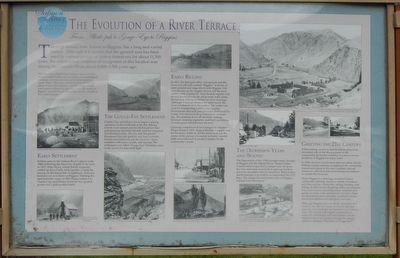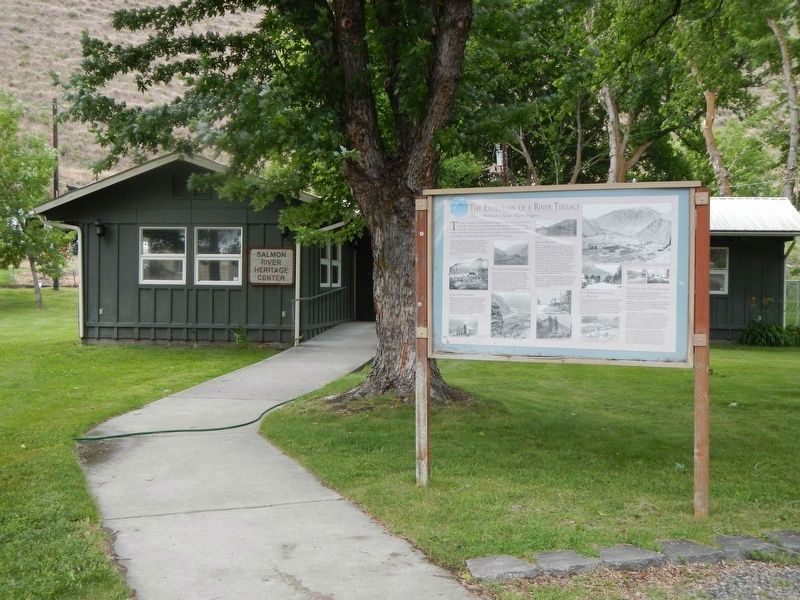Riggins in Idaho County, Idaho — The American West (Mountains)
The Evolution of a River Terrace
From Allatlo'puh to Gouge-Eye to Riggins
— Salmon River Heritage Waking Tour —
The Nez Perce (NiMii'Puu) Indians have used this area for at least 4,500 years, according to archaeological evidence, and had several permanent seasonal camps here. The place was known as Allatlo'puh, place of the yellowjackets, and the village which was located adjacent to the river front near the enter of Riggins was known as Meolpellyee'we wee, mouth of the Little Salmon.
Early Settlement
Settlers came to the Salmon River Canyon in the 1860s following the discovery of gold in the area. In 1873, Mike Deasy, whose family originally settled up Race Creek, took squatter's rights for mining on the barren flat of sagebrush, sand, boulders down known as Riggins. Thinking the land had little value, in 1891 Easy traded it to Charle Clay and Johnny Irwin for two spotted ponies and a gold pocket watch.
The Gouge-Eye Settlement
Charlie Clay and Johnny Irwin began a mining operation on the north end of the flat. Mining activity soon waned and the ditch built for their gold-panning operation became used for irrigation and drinking water. The dry arid flat quickly blossomed into rich gardens and fruit orchards. Homes soon followed and the town was born, complete with stores, hotels, and saloons. The settlement was called "Gouge-Eye" for many ears as a result of a dancehall fight.
Early Riggins
In 1901, the first post office was opened, and the town was officially named "Riggins: in honor of early pioneer and stage driver John Riggins. Life was not easy in the rugged canyon, but the early settlers were a hardy lot. They hauled supplies and move livestock over the steep rocky trails along the Salmon, relying on ferries for river crossings. Although it was a obstacle for early travel, the river was beneficial to the settlers. The water was used for transporting lumber and supplies downstream and each year provided driftwood for winter fires and ice to be preserved for summer use. The pioneers lived off the land - raising livestock, farming vegetables and fruit, and dining on wild game and fish from the river.
Upon the completion of the Orangeville-Meadows Wagon Road in 1903, Riggins became a supply stop for the heavy traffic to nearby mines and was the center of the canyon's livestock industry. Lumber mills soon followed to produce lumber for the community's needs.
The Depression Years and Beyond
The Depression of the 1930s brought many changes to Riggins and the Salmon Rivere. Three Civilian Conservation Corp (CCC) camps were set up in the area and roads were built to open up territory previously accessible only by horseback. More homes and businesses were built to accommodate the CCC-boys. The simple life and pioneer days of Riggins seemed to be left behind.
Greeting the 21st Century
While mining, ranching and recreation played an important role in the development of the community, the timber industry was the economic backbone of Riggins for may years.
In 1982, the local mill burned and was never rebuilt. Without a major industry or employer, the community turned once again to the area's pristine resources - the river and surrounding mountains - to sustain the economy.
Today Riggins is a thriving, recreation-based community offering visitors a variety of outdoor activities such as whitewater rafting, hunting, and fishing. It offers tourist shopping, visitor accommodations and services including many outfitters and guides to assist with recreational activities. There are churches to serve all faiths, excellent schools, municipal utilities and emergency services.
Although Riggins now has all amenities of the modern city, the slow pace of country living and peaceful surroundings can transport you back in time. The remote and rugged countryside is relatively unchanged and uninhabited and the sound of the river echoing through the canyon seems to whisper. "Welcome to Gouge-Eye!"
Erected by City of Riggins.
Topics. This historical marker is listed in these topic lists: Industry & Commerce • Settlements & Settlers.
Location. 45° 25.326′ N, 116° 18.966′ W. Marker is in Riggins, Idaho, in Idaho County. Marker is on Lodge Street near North Main Street (U.S. 95). Touch for map. Marker is at or near this postal address: 119 Lodge Street, Riggins ID 83549, United States of America. Touch for directions.
Other nearby markers. At least 8 other markers are within walking distance of this marker. Riggins in the 1940s (within shouting distance of this marker); Early Businesses (within shouting distance of this marker); Riggins' Early Hotels (about 300 feet away, measured in a direct line); Clay's Swinging Bridge (about 500 feet away); Educating Riggins' Children (about 500 feet away); The Forest Service (about 500 feet away); Gouge-Eye Legend (about 700 feet away); You’ve Got Mail (approx. 0.2 miles away). Touch for a list and map of all markers in Riggins.
Also see . . . Riggins unveils trail of history -- Lewiston Tribune. From its beginnings as Gouge-Eye to today's rafting and fishing kingdom, Riggins has as vivid a past as any pioneer town. Now visitors can take a walk through that history. (Submitted on June 30, 2018, by Barry Swackhamer of Brentwood, California.)
Credits. This page was last revised on June 30, 2018. It was originally submitted on June 30, 2018, by Barry Swackhamer of Brentwood, California. This page has been viewed 179 times since then and 12 times this year. Photos: 1, 2. submitted on June 30, 2018, by Barry Swackhamer of Brentwood, California.

